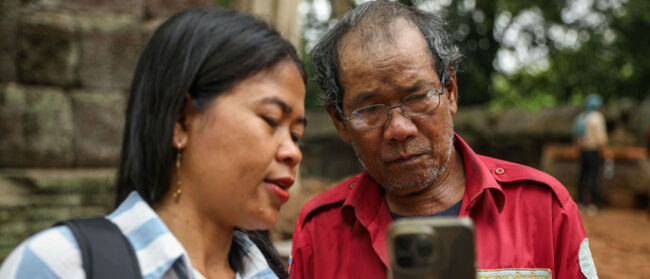Cambodia’s King-Father, Norodom Sihanouk, was cremated in a public ceremony on the evening of February 4. In Phnom Penh, more than one million mourners lined the streets while government officials, members of the royal family, Buddhist clergy and foreign dignitaries clustered around the towering Veal Preah Meru stupa to witness the cremation. Daniel Otis provides a glimpse of the final event.
By Daniel Otis Photographs by Philip Heijmans and Lim Mengkong
As tangerine light fills the western horizon, sparrows flitting through the trees surrounding Veal Preah Meru take up a frantic, cacophonous cry. The lights lining the stupa and its pavilions flicker to life. Mourners and dignitaries grow hushed and rise for a better view. The jangling of generals in medal-cluttered uniforms. Royal cousins in peaked white hats and robes. Others: white suits, black suits, armbands in black and white. White sarongs and dinner jackets. Hard-faced security personnel. Helmeted honour guards clutching polished scabbards.
King Norodom Sihamoni and the Queen Mother, Norodom Monineath, enter the saffron and gilt stupa. The orange-robed monks’ sonorous chants rise. Within the sanctuary, the King and Queen Mother bow, kneel, and pray at the open casket. The room is filled with white flowers, draped in cream and gold tapestries. The Queen Mother dries her eyes and bids farewell to what was Norodom Sihanouk.
King, prince, prime minister, statesman, rebel – for more than 70 years, Sihanouk and his country’s unravelling drama were intimately intertwined. On the streets of Phnom Penh, the affection for the late King is palpable: tears, vigils, offerings, prayers. With love, the father of Cambodian independence fought and blundered to better his country. Now, after a decade of peace and growth in the firm grip of other hands, Cambodia’s future promises hope while remaining uncertain.
The sky shifts to violet. Within the stupa, lit candles are seen. Princes and princesses peer at their father for the last time while monks continue to chant over the body. At the late monarch’s head, Prime Minister Hun Sen stands alongside King Sihamoni. The soldier and the artist. They place candles inside the open casket, lighting the pyre. Hun Sen stares at a former rival he surely admires; Sihamoni sees a beloved father and a ruler he will not be.
The crack of artillery silences the birds.
Only priests remain in the stupa. Fireworks splash red, white and gold. Around Veal Preah Meru, mourners pray and fall to their knees. An opaque screen is drawn around the pyre. Through it, there are shadows of smoke then the glow of flames. Flames rising, licking flesh, dissolving it, returning it to the state of obliteration from which every man, beast and king rises. Smoke emerging from the stupa’s tiered roof. The flames grow taller to the sounds of reed flutes and drums. People watch silently as the blackening sky fills with smoke and light.









